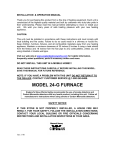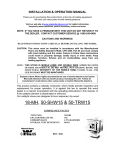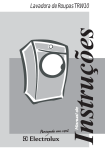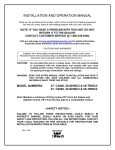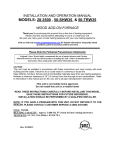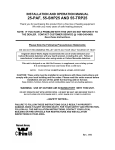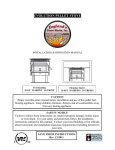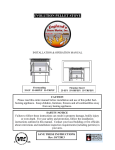Download England's Stove Works 18-TR Owner's Manual
Transcript
INSTALLATION & OPERATION MANUAL MODEL NUMBERS: 18-TR 50-SHW10 50-TRW10 18-TRD 50-SHW10D 50-TRW10D (NOTE: MANUAL ALSO APPLIES TO 50-SHW10DL) Thank you for purchasing this product from a fine line of heating equipment. We wish you many years of safe heating pleasure with your new heating appliance. Save These Instructions. NOTE: IF YOU HAVE A PROBLEM WITH THIS UNIT DO NOT RETURN IT TO THE DEALER. CONTACT CUSTOMER SERVICE @ 1-800-245-6489. Questions? Need Parts or Options? http://www.englanderstoves.com/ Please Note the Following Precautionary Statements: England’s Stove Works highly recommends the use of smoke detectors and Carbon Monoxide detectors with any hearth product, including this unit. Follow all manufacturer’s instructions when using smoke or Carbon Monoxide detectors. CAUTION: This unit must be installed in accordance with these instructions and must comply with local building and fire codes. Failure to do so could result in a chimney or house fire. Keep children, furniture, fixtures, and all combustible materials away from any heating appliance. Maintain a minimum clearance of 30 inches (6” if using a heat shield) from the firebox and 18 inches from flue pipe to any combustibles, unless you are using shielded or double wall pipe. DO NOT INSTALL THIS UNIT IN A MOBILE HOME!!! READ THESE INSTRUCTIONS CAREFULLY BEFORE INSTALLING THIS MODEL. SAVE THIS MANUAL FOR FUTURE REFERENCE. Non-Effected Facility 35 to 1 Air to Fuel Ratio SAFETY NOTICE IF THIS STOVE IS NOT PROPERLY INSTALLED, A HOUSE FIRE MAY RESULT. FOR YOUR SAFETY, FOLLOW THE INSTALLATION DIRECTIONS. CONTACT YOUR LOCAL BUILDING OR FIRE OFFICIALS CONCERNING RESTRICTIONS AND INSTALLATION INSPECTIONS IN YOUR AREA. Rev. 8/06 A letter from our Technical Support department: Thank you for purchasing this fine product from England’s Stove Works! England's Stove Works was started, and is still owned by, a family that believes strongly in a "Do It Yourself" spirit – that’s one reason you found this product at your favorite “Do It Yourself” store. We intentionally design and build our stoves so that any homeowner can maintain his or her unit with basic tools, and we're always more than happy to show you how to do the job as easily and as inexpensively as possible. From our free, downloadable service sheets; to our Pellet Service Video; to our new "wizard-style," click-through Troubleshooting guide on our web site, we have always tried to help our customers stay "heat-ready," especially when oil and electricity prices continue to skyrocket. Please look at our vast Help section on our web site and call our Customer Service department at (800) 245-6489 if you need any help with your unit. We are nearly always able to help “walk you through” any repairs, problems or questions you may have. PLEASE NOTE: While information obtained on our web site and through our 800 number is always free of charge, there will be a service charge incurred with any “on-site” repairs or maintenance that we may arrange. Wishing you years of efficient, quality and “comfy” heating, England’s Stove Works Technical Support Department www.englanderstoves.com (800) 245-6489 IF YOU HAVE A PROBLEM WITH THIS UNIT DO NOT RETURN IT TO THE DEALER. CONTACT CUSTOMER SERVICE at 1 (800) 245-6489. SECTION I: FLUE SYSTEM A. Existing Flue System If you have chosen a freestanding unit, this stove is designed to connect to an existing flue system, such as masonry or a pre-manufactured Class A flue system. If you have a masonry flue system, the inner liner should be inspected carefully for cracks; if there is no liner in your chimney, we recommend you install a steel liner or have one installed. If you have an existing pre-manufactured system the inner liner should be inspected for warping or buckling. Either type chimney system should be thoroughly cleaned before installing your new stove. We strongly recommend you have a qualified chimney sweep clean and inspect your entire system, as the sweep can spot problems you might overlook. The sweep in most cases can make any necessary repairs or recommend a qualified person to do so. It is not permissible to connect this unit to a chimney that is servicing another unit. B. Flue Size The proper flue size is determined by measuring the inside diameter of the flue collar on the unit. This stove is equipped with a six inch (6”) TOP EXHAUST FLUE COLLAR. Therefore, the connector pipe should be six inches (6”) and never less in diameter than the collar on the stove. The area of the chimney liner must also be equal to or greater than the area of the flue collar on the stove. If the area of the flue is greater than the collar, it should never be more than three (3) times greater. Example: The area of a six inch (6”) diameter flue collar is 28.87 square inches, therefore the connector pipe should be at least six inches (6”) in diameter but no greater than 84.8 square inches. The black connector pipe should be 24 gauge steel and eighteen inches (18”) from a combustible wall or ceiling. This clearance can be reduced to six inches (6”) if you are using a double wall or shielded pipe. C. Installation of a New Flue System 1. Masonry Flue: In the event that you plan to install or have a system installed, there are several approaches that you can take. In the middle and late seventies masonry flue systems became very popular, and today this type system is satisfactory. If you are considering a masonry system, you should consult with your local building officials for the proper procedures on this type chimney. We recommend you consult with and have your flue built by a licensed, bonded contractor. Most masonry chimney systems are placed against an outside wall and extend upward beside the house. The flue thimble is then inserted through the wall, making the connection with the stovepipe and the vertical flue. Exercise extreme caution when drilling through the wall -- you must maintain proper clearance between the connecting liner and any combustible material in the wall. We also recommend you have a flue clean-out door located at least two feet (2’) below your thimble for easy cleaning of the system. This door should be made as airtight as possible. It is the consumer’s responsibility to ensure the chimney system is safe and in good operating condition. The manufacturer will not be held responsible for an accident attributed to a unit connected to a faulty chimney system. Installation using UL Approved PreManufactured Chimney Installation Using a Masonry Chimney *IMPROPER INSTALLATION: The manufacturer will not be held responsible for damage caused by the malfunction of a stove due to improper installation. Call (800-245-6489) and/or consult a professional installer if you have any questions. 2. Pre-Manufactured Flue System: In the past few years pre-manufactured flue systems have become very popular, because this type system is easily installed and, when done correctly, is very safe. There are many pre-manufactured flue systems on the market, and when making your choice it should be U.L., B.O.C.A. or I.C.B.O. approved. Any of these systems are constructed of the proper materials and meet the proper safety standards. Your local dealer normally handles an approved brand of flue pipe. There are two very popular methods for installation of this type system. The first, most popular and least expensive is through the ceiling and out the roof. This is the most direct route and creates a good draw because it requires less pipe. It is less expensive because insulated pipe is needed only from the ceiling to the roof and above -single wall 24 gauge or thicker pipe is used from the unit to the ceiling if you maintain the eighteen inches (18”) clearance from all combustible material. The second method for installing a pre-manufactured system is to exit through the wall and run the system vertically up the outside of the structure. This method is more expensive because more insulated pipe is required -- you must use insulated pipe through the wall and up the outside of the structure. In either installation, proper clearances to combustibles should be maintained. Your flue pipe manufacturer furnishes a wall thimble or ceiling support box and, when installed properly, the correct clearances are achieved. If you are unable to install this type system your local dealer may be able to recommend a qualified contractor for this installation. It is the customer’s responsibility to ensure that his system is installed properly and is in good operating condition. The manufacturer will not be responsible for an accident caused by a unit connected to a faulty flue system. SECTION II: FLOOR AND WALL PROTECTION A. Floor Protection You will not need any floor protection if your floor is constructed of a non-combustible material such as brick or concrete. If your floor is constructed with a combustible material such as hardwood, carpet or linoleum, you must place protection between the stove and the combustible material. There are many floor and wall board manufacturers, and you should be very cautious in choosing the proper protection. The type board you choose should be U.L. rated and listed. After examining the area you plan to place your stove and determining it requires a board, the next step is to select the proper size. The stove you choose will determine the size board that is required. The approved protector board should be large enough to provide a minimum of eight inches (8”) behind the unit, eight inches (8”) on either side and sixteen inches (16”) in the front where the door is located. This stove requires a minimum of 36” x 48” floor protection. Remember that, as with any appliance, there is user responsibility involved, including installation, operation and maintenance of this product. Be sure to check local codes, and call Customer Service at (800) 245-6489 if you have any questions. B. Wall Protection Your unit can be placed within thirty inches (30”) of a combustible wall such as paneling, wallpaper or drywall. In some areas local codes may require thirty-six inches (36”) from a combustible, therefore it is very important that you check with local officials. If you need to place your unit closer to a combustible wall, some protection will be necessary. If an approved wall board is used this will reduce your clearance by two thirds (2/3); however, a one inch (1”) air space has to be between the board and the wall. If you have a ceiling flue hook-up, you will need protection from the floor to the ceiling if you do not meet the normal clearances. If you have a wall flue hook up, you will need wall protection at least twelve inches (12”) above the wall thimble. C. Heat Shields The freestanding models have weld nuts on the rear of the units for attaching optional heat shields. If you add a heat shield to your stove, the clearance to a combustible can be reduced to six inches (6”) without any wall protection. There are two accessory heat shields available for this unit. The AC-20 Rear Heat Shield is equipped with a circulating fan that attaches to the back of the stove, which will also increase the heating capacity of the stove. This heat shield is recommended for a parallel wall installation. The AC-PHS Side and Rear Heat Shield attaches to the rear of the unit and also covers eleven inches (11”) on each side of the stove. This heat shield will allow a six inch (6”) clearance to a combustible from the rear of the unit -- the thirty inches (30”) clearance will still be required on the sides of the stove. If you place the unit six inches (6”) from a combustible the flue pipe will be closer than eighteen inches (18”), therefore, you will have to use double wall or shielded pipe. This will allow your pipe to be within six inches (6”) of a combustible. Note: Flue systems and flue pipe are not furnished with the unit. SECTION III: FREESTANDING PLACEMENT AND INSTALLATION The first problem you may encounter is getting your stove into your home -- all of our stove products are well constructed, which makes them rather heavy. Three to four adults can normally handle a unit, but we still recommend using a handcart. Never attempt to handle a heating product alone!!! The door and firebrick can be removed to lighten the unit; if this is done please make a note of the brick placement beforehand. After the unit is placed into position, install the flue collar, spring handles and attach any optional equipment. Chimney Connector Pipe The black pipe must be six inches (6”) in diameter and at least 24 gauge steel pipe. Do not use aluminum or galvanized steel pipe, as it will not withstand the extreme temperatures generated by the stove. Also, do not use single wall connector pipe as a chimney -- you must connect your stove to a chimney comparable to those listed in Section I of this manual. The crimped end of your pipe should be inserted into the flue collar and, by doing this, all the pipe will be reversed. If you use this method the creosote will run back down the inside of your pipe and not out of the joints onto your stove. As a safety precaution, all joints should be sealed with high temperature silicone (ACRTV3) and secured with sheet metal screws. For proper operation the chimney connector should be as short as possible and never exceed a six foot (6’) horizontal run. Horizontal runs of chimney connector pipe should have an upward slope of one quarter of an inch (1/4”) per foot. You will need to maintain eighteen inches (18”) of clearance from the wall and ceiling unless you are using double wall or shielded pipe. NOTE: Be sure to follow the directions of all manufacturers of third party products that you use, including floor/wall protection or pipe. SECTION IV: ACCESSORY ITEMS AC-101-P, AC-101-PBN (SH-101-P) Brass Lip Trim There are two (2) pieces of J-Channel Trim that snap onto the edges of the stove. Remove the protective backing on the trim and match the piece with proper edge. The trim simply snaps over the corresponding edge of the unit. AC-106-P, AC-106-PBN (SH-106-P) Brass Window Trim This trim can be attached by using the spring clip and high temperature silicone. Insert the tee end of the spring clip into the opening on the edge of the trim – this will allow the spring to fall into the groove. The spring clip will hold better if it is placed on the bottom edge of the trim. If required, the silicone can be used on all four (4) corners. AC-20, AC-20B (SH-20) Rear Heat Shield With Blower This accessory is furnished complete with the installation hardware. Upon receiving this accessory, you will need to remove the rheostat (variable speed control knob) and nut from the blower. This will need to be reinstalled with the shaft through the hole in the heat shield. You can then mount the shield to the stove by securing the bolts into the weld nuts on the back of the unit. Installation of the AC-20 will allow six inches (6”) clearance from the rear of the unit to a combustible, however, you will still need thirty inches (30”) clearance on the sides (see plate on the side of the stove). AC-PHS, AC-PHSB (SH-HS10) Heat Shield This accessory is a one-piece heat shield that covers the rear of the unit as well as twelve inches on the sides. It can be installed by aligning the shield with the weld nuts on the rear of the unit and simply attaching it with the two screws. Installation of this shield will allow six inches (6”) clearance from the rear to a combustible surface, but you will still need thirty inches (30”) clearance on each side of the unit where there is no heat shield protection. You may order parts and options on our web site: www.englandsstoveworks.com , or by calling (800) 516-3636 SECTION V: OPERATING INSTRUCTIONS A. Building a Fire This unit has a 35 to 1 air to fuel ratio since there is no draft adjustment on the stove. The combustion air control is the six inch (6”) flue damper, which is placed in the middle of the first pipe section. CAUTION: NEVER USE KEROSENE, GASOLINE, DIESEL FUEL, CHARCOAL LIGHTER FLUID, LANTERN FUEL OR ANY OTHER FLAMMABLE LIQUID TO LIGHT OR RE-KINDLE A FIRE. NOTICE: Your new unit and the connector pipe may smoke for short period of time. This is called “cooking out” and is no cause for alarm. It is a good idea to open all doors and windows in your dwelling during the first few hours of operation. 1. Place several wads of crushed paper over the entire bottom of the stove. 2. Place small dry sticks (kindling) of wood on the paper. 3. Be absolutely sure there are no combustibles in the immediate area of the stove. 4. Open the cast iron damper in the flue pipe. 5. Ignite the paper and leave the door cracked open until the fire is burning freely. 6. Once the kindling is burning freely, add several pieces of split dry wood to the fire. Allow this wood to start burning well before closing the door completely. 7. Close the door and adjust the damper in the flue pipe. B. Do Not Over-Fire Your Unit The use of flammable liquids, too much wood or burning trash in the stove may result in an “over-fired” unit. If the chimney connector pipe or stove turns red or white, the stove has been over-fired. In the event this happens, close the flue damper immediately! This condition can ignite creosote in the chimney and cause a house or chimney fire. This type fire can cause structural damage to the chimney system; do not use the stove again until the entire system has been checked thoroughly and any damaged parts repaired or replaced. A chimney sweep can normally perform this inspection. C. Every Day Fueling Prior to reloading with wood, always open the damper and crack the door to allow excess smoke to clear out of your flue system; you should allow five to ten minutes before opening the door completely. This unit is designed to burn four to five hours on one good load of seasoned wood. Prior to loading with new wood, pull the hot ashes to the front edge of the stove, and fill the unit with seasoned wood. Allow the stove to burn freely for at least fifteen minutes before closing the door -- once you have a good burn, close the door and adjust the flue damper for your desired heat level. Follow this procedure each time you add fuel to the unit. D. Ash Removal and Disposal Regularly inspect the ash build-up in your stove and remove as necessary. Ashes can be removed from the 18-TR/50-SHW10/50-TRW10 by shoveling them off the firebrick. The 18TRD/50-SHW10D/50-TRW10D has an ash dump plate that can be removed from the stove; once removed the ashes can be raked through the opening and will fall into the ash pan. Caution: The ash dump plate can be extremely hot!! Never remove red-hot ashes from the stove; allow ashes to cool before dropping into the ash pan. Ashes should be placed in a metal container with an airtight lid. The ashes should be placed on a noncombustible surface and completely away from any combustible materials. The ashes should remain in the airtight container until they have completely cooled. SECTION VI: CARE AND MAINTENANCE A. Gaskets IMPORTANT: Improper gasket maintenance, including failure to replace gaskets, can cause air leaks resulting in smoke-backs. Each unit is equipped with a gasket kit around the door, which should be replaced every two years. To remove the old gasket, pull it from the channel and scrape off any old adhesive, then place new adhesive in the channel and then the new gasket. Close the door and allow twentyfour hours for the cement to harden prior to building a fire. To replace the gasket around the glass, remove the glass from the door and pull off the old gasket. Be sure to scrape off any old gasket adhesive that is on the glass. This kit already has adhesive on the gasket and can be placed on the glass by making a “u” with your fingers and running the gasket around the outside of the glass. Cut off any excess gasket and place the window back in the stove door. The replacement gasket for the door is part #AC-DGKC and the window gasket kit is part #AC-GGK. Both can be purchased from your local dealer or ordered from the factory. B. Firebrick (Part #AC-SB; 20 Required) This stove is equipped with high density, high temperature firebrick. If the brick becomes chipped or cracked, especially on the sides of the firebox, it should be replaced. This item can be ordered from your local dealer or from the factory. C. Finish (Part #AC-MCSP or AC-MBSP) Your stove has been painted with 1200 degree Fahrenheit paint that will retain its original look for several years. If your stove gets wet and rust spots appear, simply buff them off with plain steel wool and repaint. We recommend using this paint, as others may not withstand the high temperatures of a wood stove and may not adhere to the surface. You can order this paint from your local dealer or directly from the factory. D. Glass Cleaning Even though this stove is equipped with an air wash system, it will be necessary to clean the window fairly often. The type wood that is burned can contribute to a dirty viewing glass; the glass can be cleaned with a stove glass cleaner or a solution of ammonia and water. SECTION VII: CHIMNEY AND FLUE PIPE MAINTENANCE A. Chimney Maintenance Cleaning your chimney is not a difficult task, however, we highly recommend a professional be contacted for this job. Not only can he clean the system, but he will also be able to perform a complete inspection of it. A professional can spot problems that you may overlook. B. Flue Pipe Maintenance When connecting your unit to the flue system, 24 gauge or thicker pipe should be used. Your pipe should be cleaned at least once a year and inspected monthly. Most people will clean their pipe and stove at the end of the heating season, as this will keep odors from entering the house during the summer months. The flue pipe should be replaced every three to five years, depending on the thickness of the pipe (thicker pipe will last longer). SECTION VIII: THINGS THAT COULD CAUSE YOUR STOVE TO SMOKE It is very important that installations are made airtight. This is best accomplished by using furnace cement at all pipe joints and where the first section enters the stove and the chimney thimble. Any existing air leaks will cause the air to draw at points where the least resistance is offered -- such places are pipe joints, flue thimble, flue openings in the chimney, ash clean-out doors and cracks in the chimney. These may cause air to enter your system and not be drawn through the stove, which could result in a cool chimney, causing the smoke to build up in the system and eventually come back into the house. This is called “back puffing” and can be helped by sealing all troublesome areas so they are airtight. There are two main causes of chimney downdrafts that cause smoke to come back into the house. One is from an air current being deflected down the chimney by nearby objects such as trees, a building or a hill. The other is that in many chimneys the flue gases chill too quickly as they pass up the chimney. When the flue gas chills too quickly, it becomes heavy and will back up in the flue system; this will often result in "back puffing," poor combustion and smoke odors in the house. Burning the stove hotter, in some cases, will correct this situation. If you have any of these problems or a poor drawing chimney system, contact your local dealer or call the factory. SECTION IX: WHAT CAUSES CREOSOTE ? Creosote is caused by the condensation of the vapor that exists in the escaping smoke -- the moisture level of your fuel will determine the density of this vapor. A severe downdraft as discussed previously will also cause creosote. Moisture will form at the coolest point in your chimney system and at this point will tend to form creosote. The ash is picked up by the moisture in the system and will build up or run back down the inside of your flue. This situation can sometimes be helped by installing an “open vented” type chimney cap, which will allow the chimney to maintain more heat to create a better draw and keep some of the wind currents from entering the flue system. This type cap will not correct a poorly constructed chimney or one in bad need of repair, however -- in some cases the system will require relining or even need to be rebuilt. REPLACEMENT PARTS AND OPTIONS AC-G9 AC-GGK AC-DGKC AC-FCGK AC-SB AC-SH AC-SHN AC-MCSP AC-MBSP CA-20 CA-6D AC-101-P AC-101-PBN AC-106-P AC-106-PBN AC-20 AC-20B AC-PHS AC-PHSB DOOR GLASS KIT WITH GASKET (9”X9”) DOOR GLASS GASKET KIT (gasket only, no glass) DOOR GASKET KIT FLUE COLLAR GASKET 9” X 4” X 1 ¼” FIREBRICK (20 REQUIRED) DOOR SPRING HANDLE (BRASS) DOOR SPRING HANDLE (NICKEL) HI-TEMPERATURE CHARCOAL PAINT HI-TEMPERATURE BLACK PAINT FLUE COLLAR (6”) 6” CAST IRON FLUE DAMPER BRASS LIP AND ASH APRON TRIM (2-PC.) BRUSHED NICKEL LIP AND ASH APRON TRIM (2-PC.) BRASS WINDOW TRIM BRUSHED NICKEL WINDOW TRIM REAR HEAT SHIELD WITH BLOWER (CHARCOAL GRAY) REAR HEAT SHIELD WITH BLOWER (BLACK) WRAP-AROUND HEAT SHIELD (CHARCOAL GRAY) WRAP-AROUND HEAT SHIELD (BLACK) All parts can be ordered from your local dealer or from the factory at 1-800-245-6489. NOTE: Parts and accessories are also available on our web site: www.englanderstoves.com CUSTOMER SERVICE DEPARTMENT P.O. BOX 206 MONROE, VA. 24574 (800-245-6489) [email protected] (Fax: 434-929-4810) Have this information on hand if you phone the factory or your dealer regarding this product. Retain for your files: Model Number __________________________ Date of Purchase ________________________ Date of Manufacture _________________ Serial #_____________________ LIMITED 5 YEAR WARRANTY FROM THE DATE OF PURCHASE TO THE ORIGINAL OWNER The manufacturer extends the following warranties: Five Year Period: 1. Carbon steel and welded seams in the firebox are covered for 5 years against splitting. 2. The cast iron door, hasp and hinges are covered for 5 years against cracking. One Year Period: 3. Component parts such as combustor housing, flue collar, flame impingement plate, baffle plate, brick retainers, combustor plate and fasteners are covered for 1 year against cracking, breakage and welded seams from separating. 4. Electrical components, accessory items, glass and the painted surface are covered for 1 year from the date of purchase. Conditions and Exclusions: Damage from over-firing will void your warranty. This warranty does not apply if damage occurs because of an accident, improper handling, improper operation, improper installation, abuse, or unauthorized repair made or attempted to be made. The manufacturer is not liable for indirect, incidental, or consequential damages in connection with the product including any cost or expense providing substitute equipment or service during periods of malfunction or nonuse. All liability for any consequential damage for breach of any written or implied warranty is disclaimed and excluded. Some states do not allow the exclusion or limitations of incidental or consequential damages, so the above may not apply to you. Procedure: Purchaser must give notice of claim of defect within the warranty period and pay transportation to and from a service center designated by the factory. The dealer from which the unit was purchased or the factory, at our option, will perform the warranty service. Other Rights: This warranty gives you specific legal rights, and you may also have other rights, which may vary from state to state. NOTE: THIS WARRANTY IS NULL AND VOID IF YOU DO NOT RETURN THE ATTACHED WARRANTY REGISTRATION WITH A COPY OF THE SALES RECEIPT WITHIN 30 DAYS FROM THE DATE OF PURCHASE. WARRANTY IS NOT TRANSFERABLE. WARRANTY REGISTRATION for England’s Stove Works Purchased by (Name) ______________________________________________ Address _________________________________________________________ City ________________________ State __________ Zip _________________ Telephone _______________________________________________________ Email Address ___________________________________________________ DEALER INFORMATION Purchased From (Dealer) ___________________________________________ Address _________________________________________________________ City ________________________ State __________ Zip _________________ UNIT INFORMATION (Please be sure to refer to sticker on back of manual or box to complete this section) Model Number _____________________ Purchase Date _________________ Purchase Price ____________________ Serial Number _____________________ Mfg. Date ______________________ How did you first hear about our product? (please check one) ___ Word of Mouth ___ Burn Trailer Demonstration ___ Internet Other: ____________________________________________________ Where did you receive information about our product? (please check one) ___ Rec’d. info. via phone ___ Dealer (Name of dealer): ______________________ ___ Internet Other: _________________________________________________ IMPORTANT NOTICE THIS REGISTRATION INFORMATION MUST BE ON FILE FOR THIS WARRANTY TO BE VALID. PLEASE MAIL THIS INFORMATION WITHIN THIRTY (30) DAYS FROM THE DATE OF PURCHASE. Mail To: England’s Stove Works, Inc. Customer Service Department P.O. Box 206 Monroe, VA 24574 Or, Fax To: (434) 929-4810 – 24 hours a day Or, now available – Go online to complete your Warranty Registration! Visit www.englanderstoves.com if you prefer to register online.













